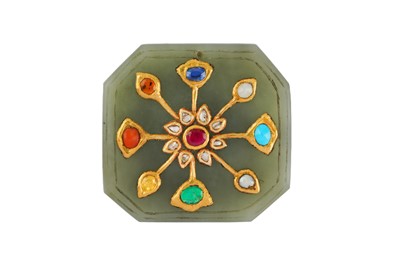28th Apr, 2023 14:00
Islamic & Indian Art
A KUNDAN-SET NINE-GEM (NAVRATNA) CARVED JADE AMULET
Mughal India, 18th century
A KUNDAN-SET NINE-GEM (NAVRATNA) CARVED JADE AMULET
Mughal India, 18th century
Of hexagonal shape, the celadon jade pendant presenting on the front a display of navratna gems (ruby, pearl, coral, garnet, blue sapphire, cat's eye, yellow topaz, emerald, and diamond) in 24ct gold kundan setting, mirroring the Navgraha Yantra, a diagram representing the nine planets of the Hindu astrological system, articulated as a floral burst with a rosette in the centre surrounded by buds and foliage, the back engraved with a passage from Sa'di's Gulistan in praise of the Prophet in the centre and invocations to 'Ali on four corners next to the Persian numeral '14', possibly a reference to the Fourteen Infallibles (Chahardah Ma'sumin) of Twelver Shi'a Islam comprising the Prophet Muhammad, his daughter Fatima, and the Twelve Shi'a Imams, 5cm x 5cm at widest points.
This amulet is a powerful example of India's long-standing and well-rooted ability to foster spiritual syncretism and to embrace the varied nature of the different religious groups inhabiting the Subcontinent. The front of the pendant is decorated with a typical kundan-set arrangement of nine gems which are supposed to represent the nine planets of traditional Hindu astrology; and yet, the reverse presents Persian poetry in praise of Muhammad and invocations to 'Ali, the Prophet's cousin, the last Rashidun of Sunni Islam and the first Imam of Shi'a Islam, indicating that the wearer was likely Muslim.
In India, blending elements from diverse spiritual beliefs to increase the auspiciousness, or 'barakah', of an object or piece of jewellery was not uncommon, and such practices became even more widespread during the Mughal era, especially after Akbar's promotion and establishment of the Din-i Ilahi in 1582. Several Mughal emperors were indeed known for wearing Hindu navratna jewellery, especially in the form of upper arm bracelets and pendants, and this trend contributed to the increased desirability of these gemological compositions and their long-lasting influence in North Indian jewellery well into the 18th and 19th centuries (Rita Devi Sharma and M. Varadarajan, Les Bijoux Artisanaux Indiens en Email, 2004, p. 42).
Dimensions: 5cm x 5cm at widest points
Sold for £688
Includes Buyer's Premium
Do you have an item similar to the item above? If so please click the link below to request a free online valuation through our website.


